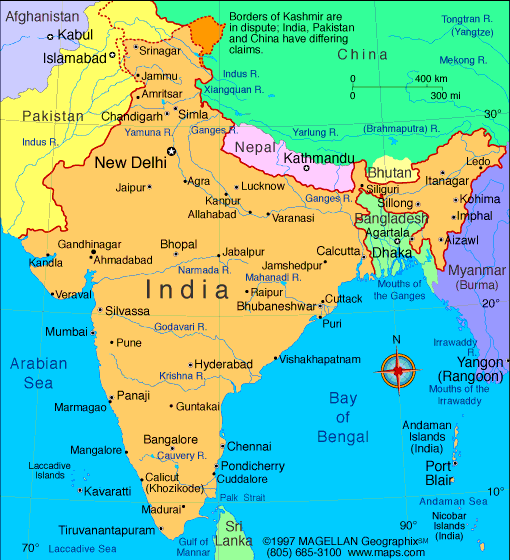India
From dKosopedia
India is the most socially diverse country on the planet, the second most populous country in Asia and the planet, and the largest country in territory and population in South Asia. India is also one of the fastest growing economies on the planet and one with an extensive though not yet enormous internal market. Despite widespread shocking levels of poverty it also has a relatively comfortable 'middle class' greater in size than the population of most countries.

Contents |
Government
India is a parliamentary and federal republic.
Cost of Diversity
Ethno-linguistic, ethno-religious, and caste/jati differences make India the most socially diverse country on the planet. Members of the Muslim minority and members of the Scheduled Castes (SCs) and Other Backward Classes (OBCs) have been subjected to centuries of social discrimination. They have been underrepresented in elective office in India since independence, however have achieved notable senior positions. Infact India's constitution was drafted by a member of Scheduled castes http://en.wikipedia.org/wiki/Ambedkar. One became India's president http://en.wikipedia.org/wiki/K._R._Narayanan and others have held positions as judges of Supreme Court, Chief Economist of India etc. Articles 330, 332 and 334 of the constitution provide for reservation of seats in the Lok Sabha or people's chamber of the Indian Parliament and the Vidhan Sabhas or the people's chambers of state assemblies. However no seats are reserved for them in the upper chambers at either the national (Rajya Sabha) or state (Vidhan Mandali) since members of upper chambers are not directly elected but nominated.
On May 14, 2006 protests by medical doctors and medical students erupted over reservations for the entrance of lower caste and non-Hindu applicants to medical schools. Their rage is driven by intense competition for a limited number of seats in medical schools. On May 19, 2006 the central lawn of the All India Institute of Medical Services was occupied by protesting medical students.
Planning Commission economist Bhalchnadra Mungekar put the social justice defense of the reservation system succinctly: "caste is qualifiaction for; caste is disqualifiaction for many." Source: Somini Sengupta. "Quotas To Aid India's Poor vs. Push For Meritocracy." The New York Times. May 22, 2006.
Population Pressure
Although China remains the most populous country at present, demographers believe that by 2050, India will have surpassed China in the "race to the bottom" of population size. In that year India will have 1.53 billion people while China will have 1.51 billion.
Paying for Prestige
The current U.S. Ambassador to India, David Campbell Mulford, is a major contributor to various Republican election campaigns. On January 26, 2006, Mulford was summoned by Indian Foreign Minister to be told that his threat that a deal transfering US nuclear technology to India could collapse if India does not back a UN motion against Iran were "inappropriate and not conducive to building a strong partnership between the two democracies." Mulford expressed his "sincere regrets." Source: n.a. "India Summons US Envoy Over Iran." BBC. January 26, 2006.
Political Parties
- Congress Party
- Bharatiya Janata Party, a.k.a. BJP or "Indian National Party"
- Dravida Munnetra Kazhagam, a.k.a. [[DMK]
Politicians in The News
References
- Jagannath Ambagudia. "From Public to Private: The Politics of Reservation Policy in India." South Asian Journal of Socio-Political Studies. Vol 6., No. 1, December 2005.
- Robert W. Stern. 2003. Changing India, 2nd Ed. Cambridge University Press. ISBN 052100912X.
![[Main Page]](../../../../upload/banner-blue-135.jpg)